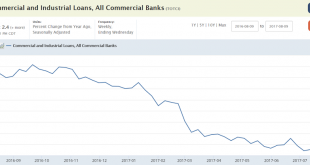from David Ruccio Russia is back in the news again in the United States, with the ongoing investigation of Russian interference in the U.S. presidential election as well as a growing set of links between a variety of figures (including Cabinet and family members) associated with Donald Trump and the regime of Vladimir Putin. This year is also the hundredth anniversary of the October Revolution, which sought to create the conditions for a transition to communism in the midst of a society...
Read More »Evolution of the Trump Administration: An Op Ed
Donald Trump seems to be missing some sort of a regulator that prevents him from simply saying what temporarily happens to be on his mind. That made it inevitable that he would treat his audience to a regular stream of faux pas. However, I think both the degree and severity of the mess may be diminished going forward. The reason has to do with how the Trump administration came into being. Simply put, unlike most candidates, he actually beat both major...
Read More »Economists — people being paid for telling stories justifying inequality
from Lars Syll If economics was an honest profession, economists would focus their efforts on documenting the waste associated with protectionist barriers for professionals. They devoted endless research studies to estimating the cost to consumers of tariffs on products like shoes and tires. It speaks to the incredible corruption of the economics profession that there are not hundreds of studies showing the loss to consumers from the barriers to trade in physicians’ services. If trade...
Read More »Credit check, Rig count, Consumer sentiment, Romney comment, Pollak comment
More of same: More evidence this has stabilized and maybe reversed: Expectations up, current conditions down: Highlights Consumer sentiment unexpectedly burst higher in the August flash but the results, warns the report, do not fully reflect the impact of the weekend’s violence in Virginia. The index rose to 97.6 which is well over Econoday’s high estimate and the strongest reading since the post-election surge in January. But the report said “too few” interviews were...
Read More »What Would Jesus Do?
First they coddled the white supremacists with false equivalency, and I didn’t resign from the Trump Evangelical Council because those protesting the white supremacists didn’t have a permit…
Read More »10 years after
from David Ruccio The crisis takes a much longer time coming than you think, and then it happens much faster than you would have thought — Rudi Dornbusch Last week, a wide variety of U.S. media (including the Wall Street Journal and USA Today) marked what they considered to be the ten-year anniversary of the beginning of the global economic crisis—from which we still haven’t recovered. The event in question, which occurred on 9 August 2007, was the announcement by international banking...
Read More »Open thread Aug. 18, 2017
Slavery, “Heritage” and Southern Fried “Free Speech”
Who knew that neo-Nazi, KKK white supremacists and Trump supporters were liars, cry-babies AND hypocrites? The reasons for secession by the states of the Confederacy were not complex or ambiguous. They are not a mystery. They were proudly proclaimed by the Confederate states. The cornerstone of the Confederacy was slavery and the conviction of the racial superiority of the White man and the social, moral and political inferiority of Africans. This was...
Read More »Symbols of Oppression Being Ignored
The Confederacy stood for the forcible subjugation of other people. If there is a benefit to honoring the concept of or symbols for the Confederacy I don’t see it. Taking these symbols out of the public sphere is a net positive, even if some people are able to simultaneously a) disassociate those symbols from the oppression they represent and b) venerate those symbols. To be consistent, note that the radical Islamic ideology also calls for the...
Read More »Industrial production, Trump comments
Worse than expected, but modest growth from depressed levels. Highlights The Federal Reserve inadvertently released what is a weak July industrial production report about a 1/2 hour early this morning. Headline production rose 0.2 percent vs expectations for 0.3 percent with manufacturing output showing outright contraction, at minus 0.1 percent vs Econoday’s consensus for a 0.2 percent gain. Capacity utilization hit expectations at 76.7 percent. A 3rd straight decline in...
Read More » Heterodox
Heterodox







